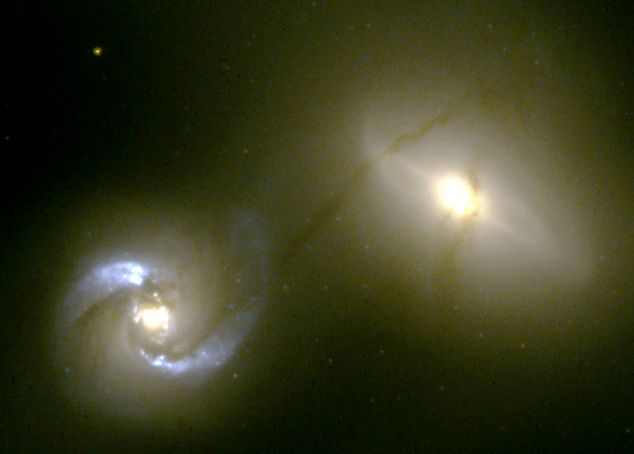Credit & Copyright: William C. Keel (Univ. Alabama, Tuscaloosa),
NASA
Explanation:
These
two galaxies are
interacting in a surprising way,
connected by a "pipeline"
of obscuring material that runs between them over 20,000 light-years
of intergalactic space.
Silhouetted by starlight,
the dark, dusty ribbon appears
to stretch from NGC 1410 (the galaxy at the left)
and wrap itself around NGC 1409 (at right).
A mere 300,000 million light-years distant in the constellation
of Taurus, the pair's
recent collision has likely drawn out this relatively
thin lane of material which is only about 500 light-years wide.
Though the Hubble Space Telescope image
dramatically
illustrates
how galaxies
exchange mater when they collide, it also presents challenges
to current pictures of
galaxy evolution.
The titanic
collision has triggered
star formation in NGC 1410 as
evidenced by its blue star forming regions, yet NGC 1409
remains devoid of hot,
young blue
stars even though observations indicate
that material is flowing into it.
Bound by gravity, these
two
galaxies are doomed to future collisions,
merging over time into one.
1999 2000 2001 2002 2003 2004 2005 2006 2007 2008 2009 2010 2011 2012 2013 2014 2015 2016 2017 2018 2019 2020 2021 2022 2023 2024 2025 |
Yanvar' Fevral' Mart Aprel' Mai Iyun' Iyul' Avgust Sentyabr' Oktyabr' Noyabr' Dekabr' |
NASA Web Site Statements, Warnings, and Disclaimers
NASA Official: Jay Norris. Specific rights apply.
A service of: LHEA at NASA / GSFC
& Michigan Tech. U.
|
Publikacii s klyuchevymi slovami:
zvezdoobrazovanie - dust - star formation - NGC 1410 - NGC 1409 - Skoplenie galaktik - vzaimodeistvuyushie galaktiki - interacting galaxies
Publikacii so slovami: zvezdoobrazovanie - dust - star formation - NGC 1410 - NGC 1409 - Skoplenie galaktik - vzaimodeistvuyushie galaktiki - interacting galaxies | |
Sm. takzhe:
Vse publikacii na tu zhe temu >> | |
